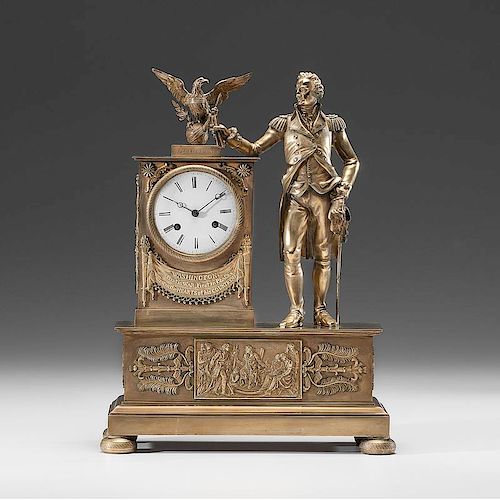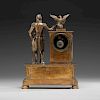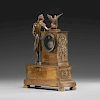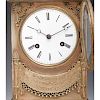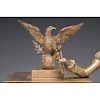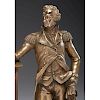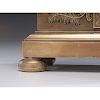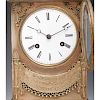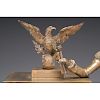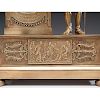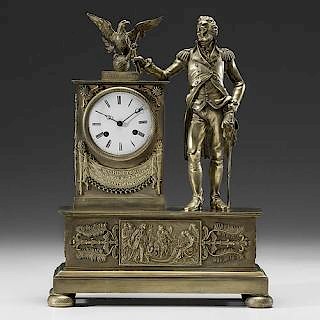A French Empire Ormolu Mantel Clock with Figure of George Washington By DuBuc, 1815-1817
About Seller
6270 Este Ave.
Cincinnati , OH 45232
United States
With offices in Cincinnati, Cleveland and Denver, Cowan’s holds over 40 auctions each year, with annual sales exceeding $16M. We reach buyers around the globe, and take pride in our reputation for integrity, customer service and great results. A full-service house, Cowan’s Auctions specializes in Am...Read more
Two ways to bid:
- Leave a max absentee bid and the platform will bid on your behalf up to your maximum bid during the live auction.
- Bid live during the auction and your bids will be submitted real-time to the auctioneer.
Bid Increments
| Price | Bid Increment |
|---|---|
| $0 | $25 |
| $500 | $50 |
| $1,000 | $100 |
| $2,000 | $250 |
| $5,000 | $500 |
| $10,000 | $1,000 |
| $20,000 | $2,500 |
| $50,000 | $5,000 |
| $100,000 | $10,000 |
About Auction
Dec 10, 2016 - Dec 11, 2016
Cowan's Auctions dawnie@cowans.com
- Lot Description
Brass case, with traces of original gilding, unmarked porcelain dial, with an eight-day time and strike movement, marked Raingo Freres, Paris; ht. 19.25, wd. 14.75, dp. 5.75 in., dial . 4 in.>
Washington is depicted as Commander in Chief, one hand resting on the pommel of his sword, the other resting on the top of the case and holding his resignation papers which he offered to Congress on December 23rd, 1783. A spread-winged eagle sits atop an orb, his talons clutching arrows and olive branches rest on a plinth engraved E. PLURIBUS UNUM. The porcelain dial is enclosed within an engine-turned ring, the case with scroll and star spandrels, a drapery swag below flanked by flaming torches and inscribed in raised lettering WASHINGTON First in WAR, First in PEACE, First in the HEARTS of his COUNTRYMEN. The right side of the case with applied bow, arrow and quiver iconography, the base with a raised plaque depicting Washington returning his sword and flanked by horizontal lyre-shaped plumage on a molded base with engine-turned bun feet.
Recent research by Lara Pascali during her studies at Winterthur between 2005 and 2006 provides new information about these much beloved mantle clocks, which appear in at least two distinct sizes. The example offered here is typical of larger versions of the clock, most of which have a dial marked Dubuc / Rue Michel-le-Comte No.33/ A PARIS. Though the dial of the lot is unmarked, there is little doubt that the case was made by the Parisian bronzier Jacques Nicolas Pierre Francois Dubuc.
On April 7, 1815, Nicolas Dubuc addressed a letter to an American gentleman in Baltimore, Maryland which subsequently appeared in several American newspapers. In his communication, DuBuc revealed plans to make Washington mantle clocks in two different sizes, approximately 15 and 20 inches in height. Pascali's research found that Dubuc was listed as a clockmaker at the Rue Michel-le-Comte address for only two years, between 1815-1817, thus providing a beginning and ending date for the manufacture of these distinctive symbols of American patriotism (see Lara Pascali, “Desirable to Patriots: French Washington Clocks for the American Market” (cited in the Baltimore Museum of Art, “Symbols of the New Republic,” [Teachers Guide, 2014, artbma.org]).
These production dates suggest the clocks were not memorials made at the time of Washington's death, as had been previously thought, but more properly relate to patriotic feelings arising from the end of the War of 1812. The Treaty of Ghent was signed on December 24, 1814; DuBuc's plans appeared in the American press a few months later.
Peter Kenny, writing for The Classical Homes Preservation Trust has recently noted:
In this context the Washington clocks can be read as allegories for a renewed sense of national purpose and identity, as well harbingers of the next chapter in American political life: the Era of Good Feelings, a period associated with the years of the Monroe presidency (1817-1825) and marked by a national mood of unity (E Pluribus Unum) and the lack of partisan factions. We had fought one revolution for our political freedom and now another for our commercial freedom. And Washington, the father of our nation, whose exploits and attributes were already engraved in the minds of all Americans, stood in 1815 as the great unifying symbol of the nation. (Peter Kenny, “Going for the Gold: Two French Ormolu Washington Clocks at Classical American Homes Preservation Trust,” http://classicalamericanhomes.org/going-for-gold, Spring-Summer 2015 Newsletter).
For a closely related example of this form, see Christie's Important American Furniture, Silver, Outsider and Folk Art, September 20, 2016, Lot 885.
Provenance:
Bertha Bartlett Benkard Rose (1904-1982)
R. Peter Rose (1927-2004)
Jeanne Chick Rose (1941-2015)
Thence by Descent to Its Present Owners
In addition, this same clock is pictured in an undated, though presumably 1950s photograph of the home of Bertha Benkard Rose in Oyster Bay, New York.
Accompanied by an undated, printed brochure published for Mrs. Reginald Rose, by David E. Heilpern, Clockmaker, North Bellmore, New York.
Provenance: Property from the Descendants of Bertha Benkard Rose, Oyster Bay, NY and Tucson, AZ
Condition
Traces of original gilding remaining, along with minor verdigris from old brass polishing; pendulum probably replaced.
- Shipping Info
-
SHIPPING. At the request of the buyer, Cowan's will authorize the shipment of purchased items. Shipments usually occur within two weeks after payment has been received. Shipment is generally made via UPS Ground service. Unless buyer gives special instructions, the shipping method shall be at the sole discretion of Cowan's Auctions, Inc.. Cowan's is in no way responsible for the acts or omissions of independent handlers, packers or shippers of purchased items or for any loss, damage or delay from the packing or shipping of any property.
-
- Buyer's Premium



 EUR
EUR CAD
CAD AUD
AUD GBP
GBP MXN
MXN HKD
HKD CNY
CNY MYR
MYR SEK
SEK SGD
SGD CHF
CHF THB
THB